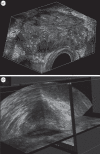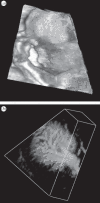Three-dimensional ultrasound scanning
- PMID: 22866228
- PMCID: PMC3262266
- DOI: 10.1098/rsfs.2011.0019
Three-dimensional ultrasound scanning
Abstract
The past two decades have witnessed developments of new imaging techniques that provide three-dimensional images about the interior of the human body in a manner never before available. Ultrasound (US) imaging is an important cost-effective technique used routinely in the management of a number of diseases. However, two-dimensional viewing of three-dimensional anatomy, using conventional two-dimensional US, limits our ability to quantify and visualize the anatomy and guide therapy, because multiple two-dimensional images must be integrated mentally. This practice is inefficient, and may lead to variability and incorrect diagnoses. Investigators and companies have addressed these limitations by developing three-dimensional US techniques. Thus, in this paper, we review the various techniques that are in current use in three-dimensional US imaging systems, with a particular emphasis placed on the geometric accuracy of the generation of three-dimensional images. The principles involved in three-dimensional US imaging are then illustrated with a diagnostic and an interventional application: (i) three-dimensional carotid US imaging for quantification and monitoring of carotid atherosclerosis and (ii) three-dimensional US-guided prostate biopsy.
Keywords: computed tomography; radiographic imaging; three-dimensional ultrasound scanning.
Figures












References
-
- Elliott S. T. 2008. Volume ultrasound: the next big thing? Br. J. Radiol. 81, 8–910.1259/bjr/13475432 (doi:10.1259/bjr/13475432) - DOI - DOI - PubMed
-
- Downey D. B., Fenster A., Williams J. C. 2000. Clinical utility of three-dimensional US. Radiographics 20, 559–571 - PubMed
-
- Hummel J., Figl M., Bax M., Bergmann H., Birkfellner W. 2008. 2D/3D registration of endoscopic ultrasound to CT volume data. Phys. Med. Biol. 53, 4303–431610.1088/0031-9155/53/16/006 (doi:10.1088/0031-9155/53/16/006) - DOI - DOI - PubMed
-
- Carson P. L., Fenster A. 2009. Anniversary paper: evolution of ultrasound physics and the role of medical physicists and the AAPM and its journal in that evolution. Med. Phys. 36, 411–42810.1118/1.2992048 (doi:10.1118/1.2992048) - DOI - DOI - PubMed
LinkOut - more resources
Full Text Sources
Other Literature Sources
Miscellaneous

